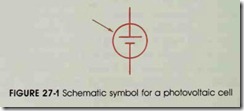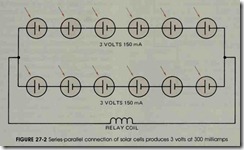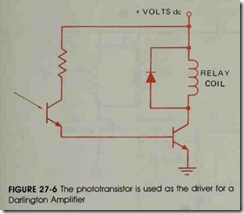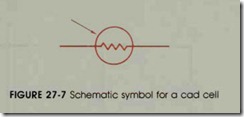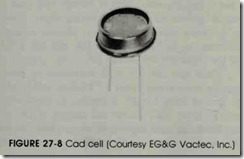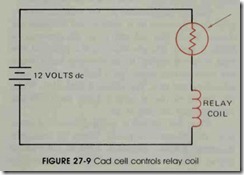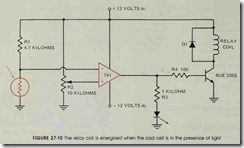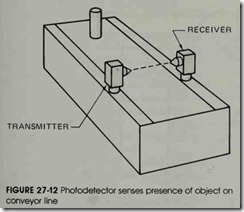Objectives
After studying this unit, the student will be able to:
• List different devices used as light sensors
• Discuss the advantages of photo-operated controls
• Describe different methods of installing photodetectors
APPLICATIONS
Photodetectors are widely used in today’s in dustry. They can be used to sense the presence or absence of almost any object. Photodetectors do not have to make physical contact with the object they are sensing, so there is no mechanical arm to wear out. Many photodetectors can operate at speeds that cannot be tolerated by mechanical con tact switches. They are used in almost every type of industry, and their uses are increasing steadily.
TYPES OF DETECTORS
Photo-operated devices fall into one of three categories: photovoltaic, photoemissive, and pho toconductive.
Photovoltaic
Photovoltaic devices are more often called so lar cells . They are made of silicon and have the ability to produce a voltage in the presence of light. The amount of voltage produced by a cell is determined by the material it is made of. When silicon is used, the solar cell produces .5 volts in the presence of direct sunlight. If there is a com plete circuit connected to the cell, current will flow through the circuit. The amount of current produced by a solar cell is determined by the sur face area of the cell. For instance, assume a solar cell has a surface area of 1 square inch, and an other cell has a surface area of 4 square inches. If both cells are made of silicon, both will produce .5 volts when in direct sunlight. The larger cell, however, will produce four times as much current as the small one.
Figure 27-1 shows the schematic symbol for a photovoltaic cell. Notice that the symbol is the same as the symbol used to represent a single cell battery except for the arrow pointing toward it. The battery symbol means the device has the abil ity to produce a voltage, and the arrow means that it must receive light to do so.
Photovoltaic cells have the advantage of being able to operate electrical equipment without exter nal power. Since silicon solar cells produce only .5 volt, it is often necessary to connect several of them together to obtain enough voltage and cur rent to operate the desired device. For example, assume that solar cells are to be used to operate a de relay coil that requires 3 volts at 250 milliamps. Now assume that the solar cells to be used have the ability to produce .5 volt at 150 milliamps. If six solar cells are connected in series, they will produce 3 volts at 150 milliamps, figure 27-2. The voltage produced by the connection is sufficient to operate the relay, but the current capacity is not. Therefore, six more solar cells must be connected in series. This connection is then connected par allel to the first connection producing a circuit that has a voltage rating of 3 volts and a current rating of 300 milliamps, which is sufficient to operate the relay coil.
Photoemissive Devices
Photoemissive devices emit electrons when in the presence of light. They include such devices as the phototransistor, the photodiode, and the photo-SCR. The schematic symbols for these de vices are shown in figure 27-3. The emission of electrons is used to turn these solid-state compo nents on. The circuit in figure 27-4 shows a pho totransistor used to turn on a relay coil. When the phototransistor is in darkness, no electrons are emitted by the base junction, and the transistor is turned off. When the phototransistor is in the presence of light, it turns on and permits current to flow through the relay coil. The diode con nected parallel to the relay coil is known as a kick back or freewheeling diode. Its function is to prevent induced voltage spikes from occurring when the current suddenly stops flowing through the coil and the magnetic field collapses.
In the circuit shown in figure 27-4, the relay coil will turn on when the phototransistor is in the presence of light, and turn off when the photo transistor is in darkness. Some circuits may re quire the reverse operation. This can be accom plished by adding a resistor and a junction transistor to the circuit, figure 27-5. In this circuit a common junction transistor is used to control the current flow through the relay coil. Resistor Rl limits the current flow through the base of the junction transistor. When the phototransistor is in darkness, it has a very high resistance. This per mits current to flow to the base of the junction transistor and turn it on. When the phototransistor is in the presence of light, it turns on and con nects the base of the junction transistor to the neg ative side of the battery. This causes the junction transistor to turn off. The phototransistor in the circuit is used as a stealer transistor. A stealer tran sistor steals the base current away from some other transistor to keep it turned off.
Some circuits may require the phototransistor to have a higher gain than it has under normal conditions :This can be accomplished by using the phototransistor as the driver for a Darlington am plifier circuit, figure 27-6. A Darlington amplifier circuit generally has a gain of over 10,000.
Photodiodes and photo-SCRS are used in circuits similar to those shown for the phototransis tor. The photodiode will permit current to flow through it in the presence of light. The photo-SCR has the same operating characteristics as a com mon junction SCR. The only difference is that light is used to trigger the gate when using a photo-SCR. Regardless of the type of photoemissive device used, or the type circuit it is used in, the greatest advantage of the photoemissive device is speed. A photoemissive device can turn on or off in a few microseconds. Photovoltaic or photocon ductive devices generally require several millisec onds to turn on or off. This makes the use of pho toemissive devices imperative in high speed switching circuits.
Photoconductive Devices
Photoconductive devices exhibit a change of resistance due to the presence or absence of light. The most common photoconductive device is the cadmium sulfide cell or cad cell. The cad cell has a resistance of about 50 ohms in direct sunlight and several hundred thousand ohms in darkness. It is generally used as a light sensitive switch. The schematic symbol for a cad cell is shown in figure 27-7. Figure 27-8 shows a typical cad cell.
Figure 27-9 shows a basic circuit of a cad cell being used to control a relay. When the cad cell is in darkness, its resistance is high. This prevents the amount of current needed to turn the relay on from flowing through the circuit. When the cad cell is in the presence of light, its resistance is low. The amount of current needed to operate the relay can now flow through the circuit.
Although this circuit will work if the cad cell is large enough to handle the current, it has a cou ple of problems.
1. There is no way to adjust the sensitivity of the circuit. Photo-operated switches are gen erally located in many different areas of a plant. The surrounding light intensity can vary from one area to another. It is, there fore, necessary to be able to adjust the sensor for the amount of light needed to operate it.
2. The sense of operation of the circuit cannot be changed. The circuit shown in figure 27- 9 permits the relay to turn on when the cad cell is in the presence of light. There may be conditions that would make it desirable to turn the relay on when the cad cell IS m darkness.
Figure 27-10 shows a photodetector circuit that uses a cad cell as the sensor and an opera tional amplifier as the control circuit. The circuit operates as follows. Resistor Rl and the cad cell form a voltage divider circuit which is connected to the inverting input of the amplifier. Resistor R2 is used as a potentiometer to preset a positive volt age at the noninverting input. This control adjusts the sensitivity of the circuit. Resistor R3 limits the current to a light-emitting diode (LED). The LED is mounted on the outside of the case of the photodetector and is used to indicate when the re lay coil is energized. Resistor R4 limits the base current to the junction transistor. The junction transistor is used to control the current needed to operate the relay coil. Many op amps do not have enough current rating to control this amount of current. Diode D 1 is used as a kickback diode.
Assume that Resistor R2 has been adjusted to provide a potential of 6 volts at the noninverting input. When the cad cell is in the presence of light, it has a low resistance and a potential less than 6 volts is applied to the inverting input. Since the noninverting input has a higher positive volt age connected to it, the output is high also. When the output of the op amp is high, the LED and the transistor are turned on.
When the cad cell is in the presence of dark ness, its resistance increases. When its resistance becomes greater than 4.7 kilohms, a voltage greater than 6 volts is applied to the inverting input. This causes the output of the op amp to change from a high state to a low state, and turn the LED and transistor off. Notice in this circuit that the relay is turned on when the cad cell is in the presence of light, and turned off when it is in darkness.
Figure 27-11 shows a connection that will re verse the operation of the circuit. The poten tiometer has been reconnected to the inverting input, and the voltage divider circuit has been connected to the noninverting input. To under stand the operation of this circuit, assume that a potential of 6 volts has been preset at the inverting input.
When the cad cell is in the presence of light, it has a low resistance and a voltage less than 6 volts is applied to the noninverting input. Since the inverting input has a greater positive voltage connected to it, the output is low and the LED and the transistor are turned off.
When the cad cell is in darkness, its resistance becomes greater than 4.7 kilohms and a volt age greater than 6 volts is applied to the nonin verting input. This causes the output of the op amp to change to a high state which turns on the LED and transistor. Notice that this circuit turns the relay on when the cad cell is in darkness and off when it is in the presence of light.
MOUNTING
Photodetectors designed for industrial use are made to be mounted and used in different ways. There are two basic types of photodetectors: one type has separate transmitter and receiver units; the other type has both units mounted in the same housing. The type used is generally determined by the job requirements. The transmitter section is the light source which is generally a long life in candescent bulb. There are photodetectors, how ever, that use an infrared transmitter. These can not be seen by the human eye and are often used in burglar alarm systems. The receiver unit houses the photodetector and, generally, the circuitry re quired to operate the system.
Figure 27-12 shows a photodetector used to detect the presence of an object on the conveyor line. When the object passes between the trans mitter and receiver units, the light beam. is broken and the detector activates. Notice that no physical contact was necessary for the photodetector to sense the presence of the object.
Figure 27-13 illustrates another method of mounting the transmitter and receiver. In this example, an object is sensed by reflecting light off of a shiny surface. Notice that the transmitter and receiver must be mounted at the same angle with respect to the object to be sensed. This type of mounting will only work with objects that have the same height, such as cans on a conveyor line.
Photodetectors that have both the transmitter and the receiver units mounted in the same hous ing depend on a reflector for operation. Figure 27- 14 shows this type of unit mounted on a conveyor line. The transmitter is aimed at the reflector. The light beam is reflected back to the receiver. When an object passes between the photodetector unit and the reflector, the light to the receiver is inter rupted. This type of unit has the advantage of needing electrical connection at only one piece of equipment. This permits easy mounting of the photodetector unit, and mounting of the reflector
in hard to reach positions that would make run ning control wiring difficult. Many of these units have a range of 20 feet and more.
Another type of unit that operates on the principle of reflected light uses an optical fiber ca ble. The fibers in the cable are divided in half. One half of the fibers is connected to the transmit ter, and the other half is connected to the receiver, figure 27-15. This unit has the advantage of per mitting the transmitter and the receiver to be mounted in a very small area. Figure 27-16 illus trates a common use for this type of unit. The unit is used to control a label cutting machine. The la bels are printed on a large roll and must be cut for individual packages. The label roll contains a nar row strip on one side which is dark colored except for shiny sections spaced at regular intervals. The optical fiber cable is located above this narrow strip. When the dark surface of the strip is passing beneath the optical cable, no reflected light re turns to the receiver unit. When the shiny section passes beneath the cable, light is reflected back to the receiver unit. The photodetector sends a signal to the control circuit and tells it to cut the label.
Photodetectors are very dependable and have an excellent maintenance and service record. They can be used to sense almost any object without making physical contact with it, and can operate millions of times without damage or wear. A vari ety of photodetectors is shown in figure 27-17.
REVIEW QUESTIONS
1. List the three major categories of photodetectors.
2. In which category does the solar cell belong?
3. In which category do phototransistors and photodiodes belong?
4. In which category does the cad cell belong?
5. The term cad cell is a common name for what device?
6. What is the function of the transmitter in a photodetector unit?
7. What is the advantage of a photodetector that uses a reflector to operate?
8. An object is to be detected by reflecting light off a shiny surface. If the transmitter is mounted at a 60 degree angle, at what angle must the receiver be mounted?
9. How much voltage is produced by a silicon solar cell?
10. What determines the amount of current a solar cell can produce?
